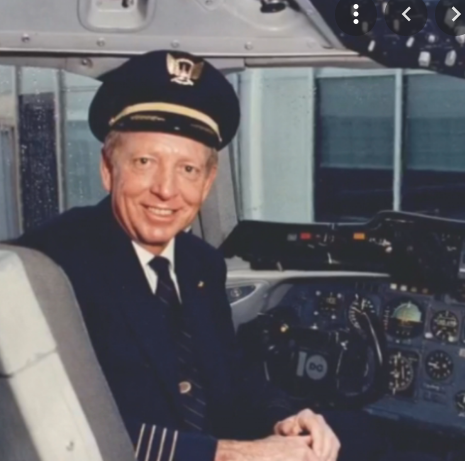In 1989, United Airlines Flight 232, became one of most striking examples of extraordinary teamwork in aviation history.
I had the distinct honor to personally interview Captain Al Haynes after the accident. Below are six crisis management lessons from the cockpit, that I drew from that interview.
_____________________
UAL Flt 232, was a DC-10 carrying 285 passengers. It had departed from Denver, and was enroute to Chicago.
An hour into the flight, while cruising at 37,000 feet, the jet experienced a catastrophic failure of the #2 engine. The explosion sent shrapnel into the fuselage, completely disabling all three of the aircraft’s redundant hydraulic systems – rendering the plane virtually uncontrollable.
With no means of controlling pitch, bank, nor airspeed, the jet began to enter a series of roller-coaster-like phugoid oscillations. Captain Haynes said the DC-10 nearly went over on it’s back three separate times. With no hydraulics, an inverted roll would most certainly develop into a graveyard spiral, all but guaranteeing no survivors.
Basically, the crew was now riding a 300,000-pound rocket, without the luxury of being able to control it.
Lesson #1 – Giving up is not an option.
The odds of losing all hydraulic power simultaneously on this aircraft, were a billion to one.
As Captain Al Haynes told me, his initial thought was, “It can’t happen. You’ve been told over and over again, it can’t happen, but it didn’t take us very long to realize, I think it just did.”
Sooner or later, most of us have to deal with the dire. Something so egregious and hopeless, that we feel completely out of control. A sudden layoff, bankruptcy, divorce, death, or serious illness, can leave us feeling hopeless. But the way you interpret the problem can make the difference between winning or losing.
By all accounts, the United predicament appeared hopeless. And by all indications, there was nothing the crew could do to change the outcome.
But sometimes, contrary to indications or probability, you have to buck the odds. To insist that somewhere, somehow, a solution exists. This is where we can learn an invaluable lesson from UAL 232: Giving up, was simply not an option.
Lesson #2 – When “pushed,” we discover untapped power
Think of how many times in your life, internal strength surfaced only after extreme pressure or adversity were thrust upon you. You had to “sink or swim.” In the final analysis, one simple truth remains: pressure empowers.
This was further confirmed after the accident, when flight crews were unable to replicate the scenario in a simulator, largely due to the absence of life-or-death pressure.
There will be times, you’re going to be pushed beyond your perceived limits. Where things may appear so hopeless, out of control, and screwed up, you’ll want to give up. But that is precisely the time you must hunker down, hold on, and fight.
In other words, don’t give up. Life has an odd way of taking us right up to the edge of the cliff, and just as we are pushed off, we get wings. In a sense, our, “human afterburner” kicks in.
Lesson #3 – Simulate in the safe crucible of chaos and challenge
One way to manage a crisis, is to practice in a realistic crucible of chaos and challenge. Airline crews are required to log simulator time on a regular basis. This provides pilots an opportunity to maintain proficiency, and experience a multitude of emergencies in a safe environment.
In a fortunate twist of fate, Denny Fitch, a DC-10 check airman and instructor, riding jump seat on Flight 232, had studied the 1985 crash of Japan Air Lines Flight 123,which experienced a similar hydraulic system failure as Flt 232. He had also practiced that same zero hydraulic situation in a flight simulator. This practice, likely aided in regaining partial aircraft control, during 232’s dilemma.
Simulation can be adapted to your personal and professional challenges as well. However, you don’t need a multi-million-dollar sim to reap the benefits. Most student pilots know the term “armchair flying” – A process where the pilot clearly imagines flying the aircraft, using nothing more than vivid mental imagery.
Armchair flying can extend to other skill sets as well. For example, in our book entitled, “SpeakEasy – How to Make your Butterflies Fly in Formation,” we teach people how to relax when speaking in front of a crowd, using the same armchair flying techniques.
You “simulate” a detailed mental image of you calmly delivering a speech. You “see” yourself relaxed, even enjoying the talk. Research has proven, your nervous system cannot tell the difference between a real or vividly imagined experience, when created in the laboratory of your mind. Sounds basic, but it works!
Lesson #4 – CRM is teamwork on steroids
After observing erratic flight behavior of the DC-10, Denny Fitch, the off-duty instructor pilot, asked one of the flight attendants if he could assist the cockpit crew. Haynes accepted.
In a beautiful display of crew resource management, Haynes had the presence of mind to recognize Fitch as a new (and welcomed) part of the team. While fighting to maintain control of the jet, Haynes proceeded to bring his hand over his right shoulder for a brief handshake introducing himself to Fitch.
Although the aircraft was now dangling on the ragged edge of uncontrolled flight, something remarkable began to transpire in the cockpit. An incredible display of teamwork and raw determination were coming together. The cockpit became a beehive of ideas. “What if we try this? Do you think this will help?”
Through a system of trial and error, the crew worked their magic. Still, the nearest airport was Sioux City, Iowa, some 75 miles away, and as Haynes admitted to me, “we had absolutely no idea how we were going to get there.”
However, as they continued to corkscrew to the right, the crew finally made a breakthrough. By jockeying the power on the two remaining engines, they gained some directional control over the airplane.
Forty-five minutes later, after an erratic flight path, the crew miraculously lined the jet up with Runway 22 at Sioux City.
Lesson #5 – A calm voice can calm a crisis
Kevin Bachman, the Sioux City tower controller, talked to the Hayne in a remarkably calm, confident manner.
It has been well documented, that calmness during calamity promotes improved performance and clearer thinking. In fact, Haynes later said Kevin’s steady voice is what helped the crew maintain focus and relative sense of calm.
Kevin ability to remain unflustered, was mirrored in Al Haynes jesting minutes from touchdown. As they approach the airport, Kevin gives the customary “cleared to land” permission, Captain Haynes provides a snapshot of his relative calm, when he banters back, “You don’t want to be particular and make it a (specific) runway, huh?”
With the aircraft now at the runway threshold and mere seconds from touchdown, the DC-10 is cursed with another phugoid oscillation. As the jet begins an uncontrollable nose down pitch, the ground proximity recorder blasts the warning, “Pull up, pull up.” A split second later, the plane begins to roll to the right. A crew member begins to holler, “Left, left, left, left!” Just then, the aircraft’s right wing digs deep into the asphalt.
Lesson #6 – When the book says “impossible”…Stop reading!
As the world witnesses the spectacular fireball on TV, few people comprehend the miracle that has just taken place – controlled flight was maintained all the way to the runway threshold. By the book, this was patently impossible. In fact, to this day, flight test crews have been unable to maintain control of a DC-10 when the situation is duplicated in a flight simulator.
By all accounts, the United jet should have spun in from 37,000 feet. And, as anyone in aviation knows, a graveyard spiral from seven miles in the sky, all but guarantees a 100 percent fatality rate. However, because the jet was relatively slow and in landing configuration, the crew, and the majority of passengers lived through an otherwise unsurvivable accident.
A number of factors contributed to the high survival rate of this flight. But the crucial component was the mindset of the crew. Packing it in, simply wasn’t an option.
The next time you feel you’re “going down,” remember this flight lesson. Never give up! Should you find yourself in a situation that appears patently impossible, ask yourself this question: Could my assessment of the situation be… patently wrong?
If you liked this “flight lesson,” would love to hear your comments. For more aviation-oriented life lessons, check out tillison.com


